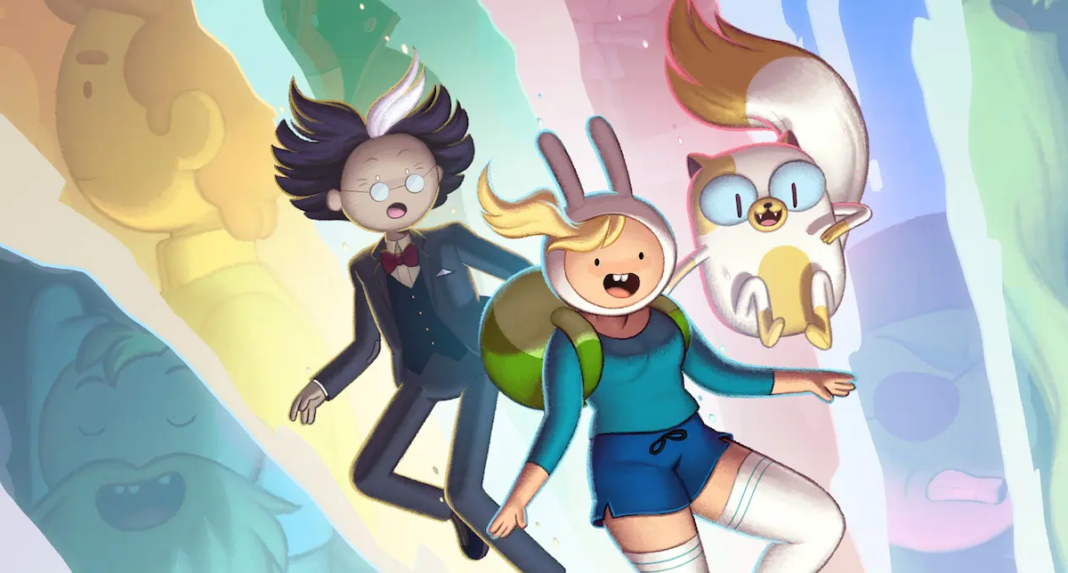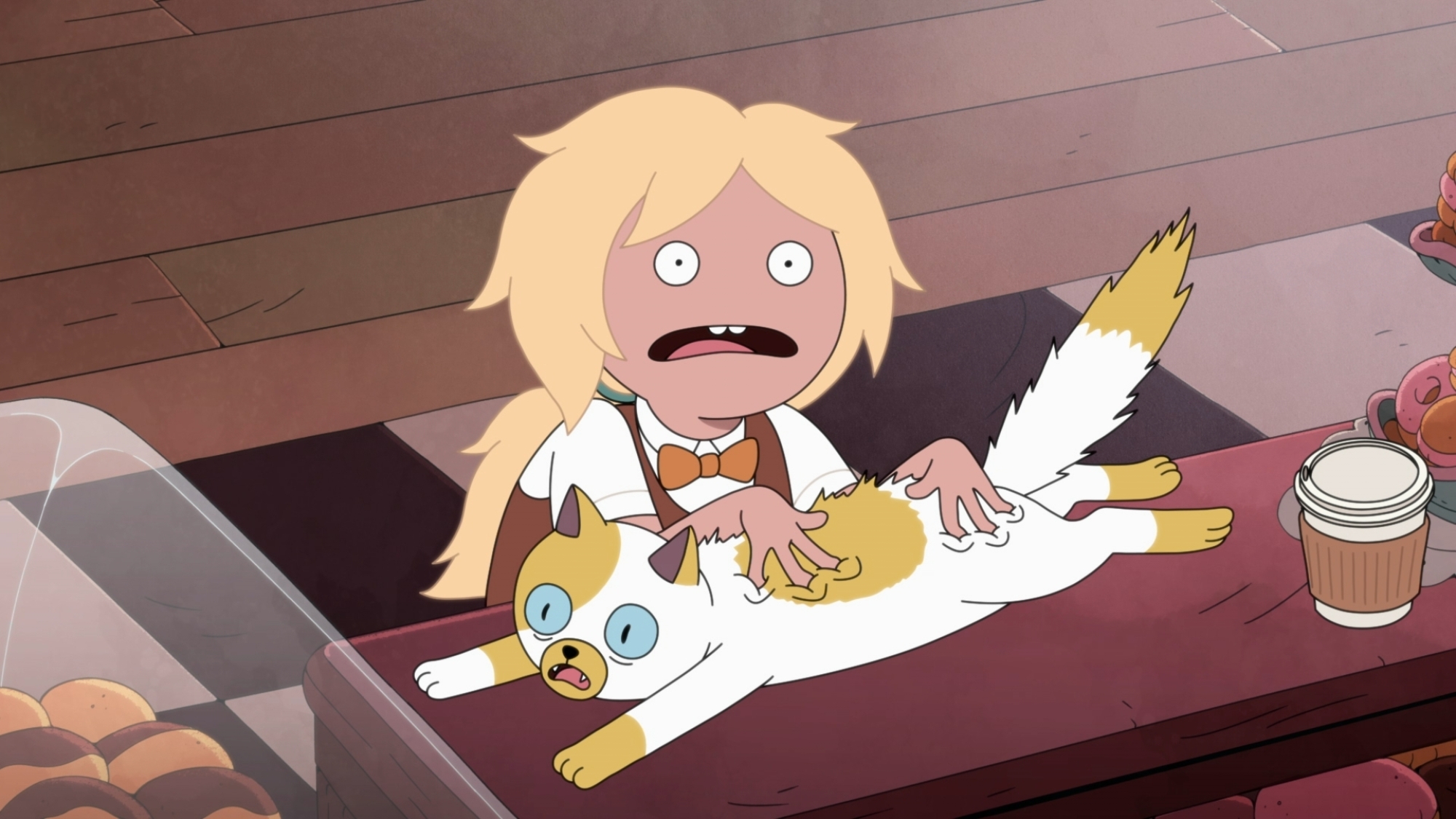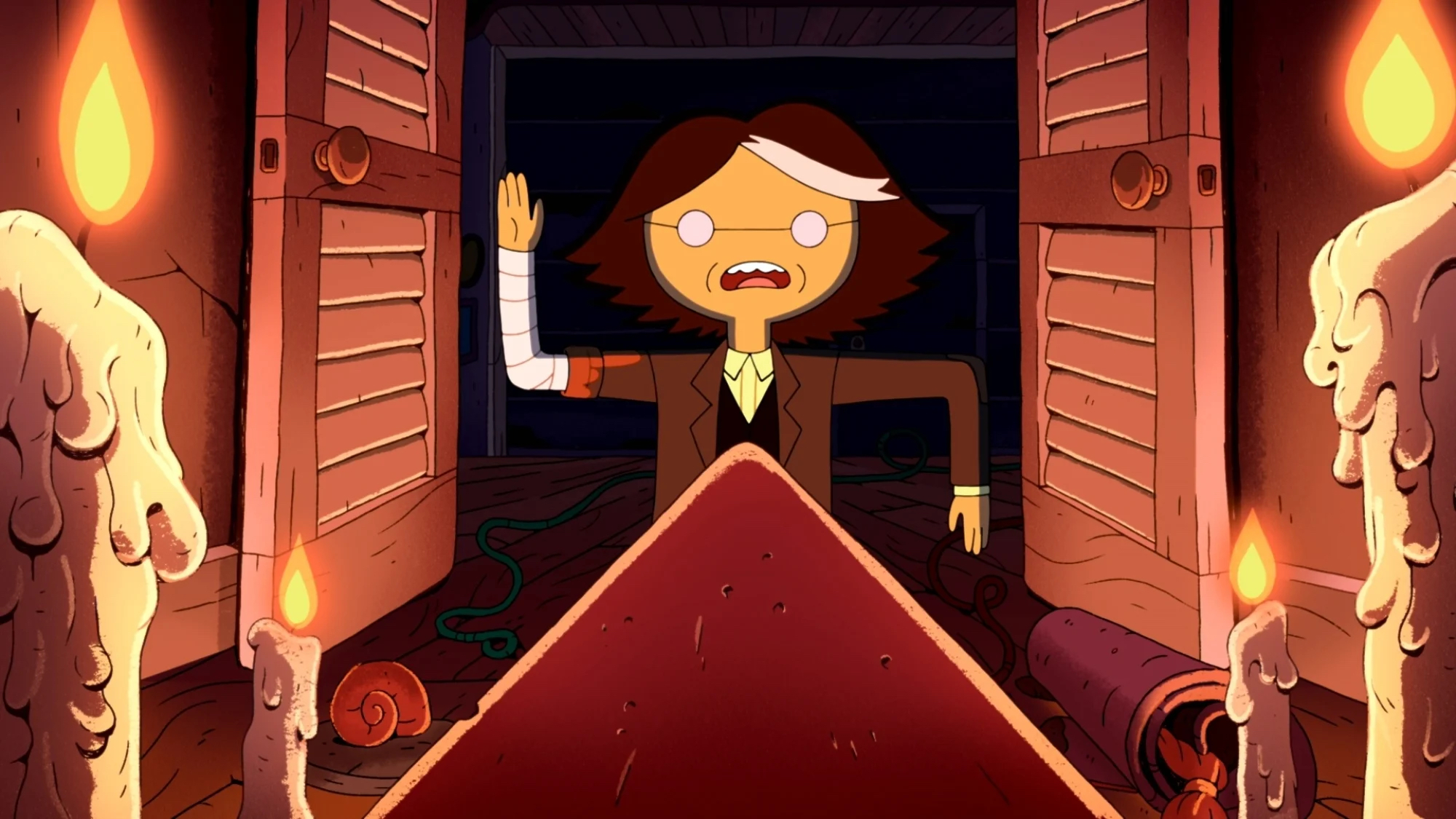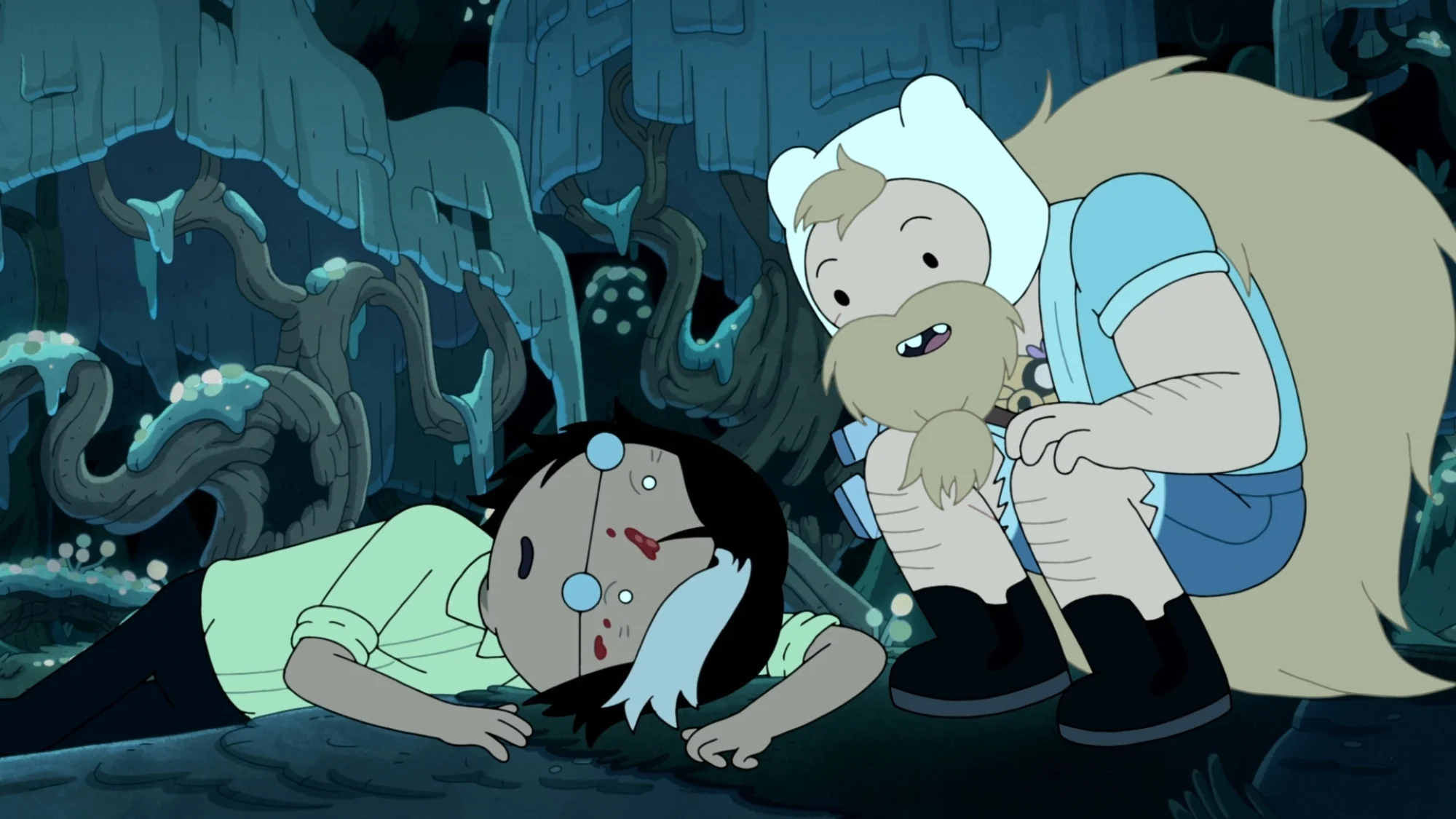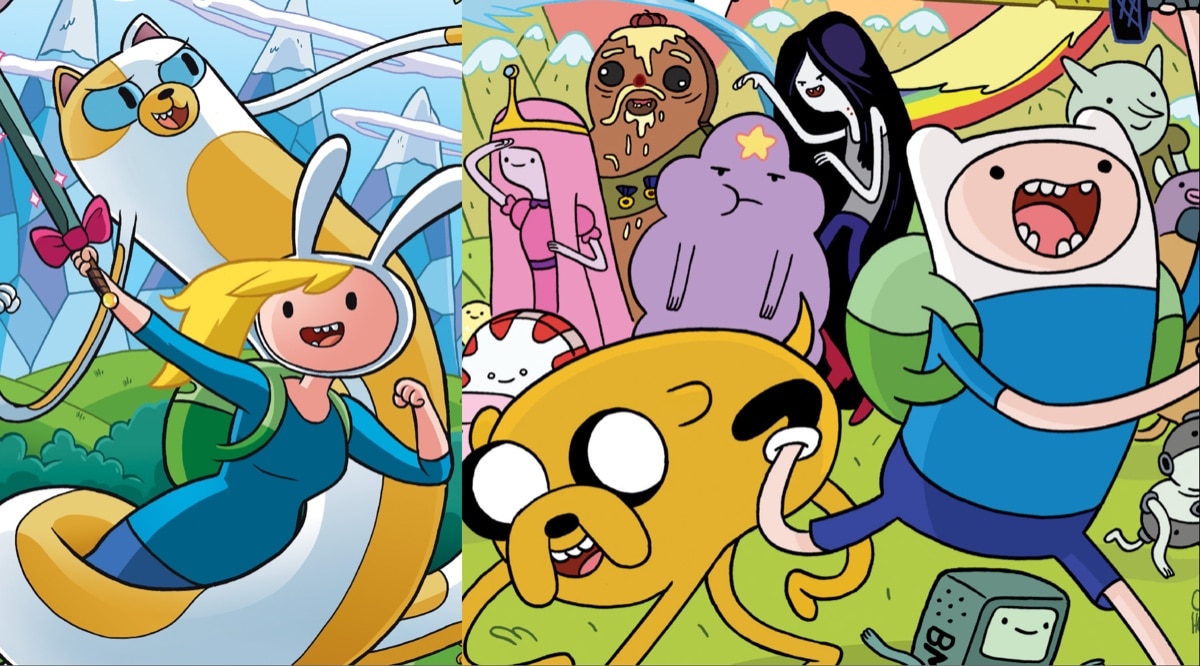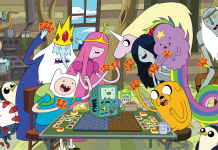This interview contains mild spoilers for Adventure Time: Fionna and Cake, all ten episodes of which are now available for streaming on Max.
In Fionna and Cake, the gender-swapped heroes at the heart of Ice King’s fanfiction step into the spotlight! The series features the return of Fionna (Madeleine Martin) and Cake (Roz Ryan), along with many other favorite characters and locales from all 10 seasons of Adventure Time and the four Adventure Time: Distant Lands specials.
The Beat caught up with Fionna and Cake showrunner Adam Muto over Zoom. We asked all about picking up continuity from Adventure Time and Distant Lands, learned about how Fionna and Cake carries on the franchise’s musical traditions, and inquired about the role of fanfiction in the spin-off series.
This interview has been edited for clarity and length.
AVERY KAPLAN: Fionna and Cake draws on an extensive amount of continuity from both Adventure Time and Distant Lands. What was the process of creating the series like? Was this a matter of picking up plan storylines, or of discovering happy continuity coincidences?
ADAM MUTO: Some of both! A lot of it was like where continuity left us off at the original series, the end of that, and what could be a good starting point or entry point for new stories, but also for people who haven’t watched the show a ton, because 10 seasons is a lot. So you want to occasionally have points where you don’t have to have done a lot of homework and kind of re-present things.
And Simon and Fionna kind of were things that we didn’t see a ton of in the original series. I mean, there were Fionna and Cake episodes, but across the life of the series only five or six, and Simon, you only usually saw as Ice King. So changing him at the end of the series left him in a place where realistically – not that we have to be realistic – but he would be a little bit traumatized. And not just back to normal and happy about being cured; or the idea of being cured might be double-edged. So it felt like that was an opportunity.
We looked for the characters that we hadn’t seen a ton that it felt like could tell a story that Finn and Jake could never do, and/or the original series couldn’t really do. And also, in a strictly business sense, Fionna and Cake were recognizable because of the similarity to Finn and Jake, and kind of playing off of that and using that as a way to get it made, but not making it about them just being Finn and Jake again.
KAPLAN: Fionna and Cake is about stories in general, but an element of the story is also specifically about fanfiction. What went into ensuring the idea of fanfiction remained present throughout the series?
MUTO: It was something in the back of our heads. We didn’t want to make any direct comments on fanfiction because it’s too big of a subject. And it’s not something for us to judge in a lot of cases. But there are certain tropes that show up a lot. So it kind of gave us a chance to ask, “What kind of story can we tell for this world that would lend itself to that trope, or to that type of story?”
And yeah, them being born out of fanfiction felt like, we couldn’t forget completely, that’s where they were from. So what they were going towards and what she was trying to get back to was sort of this idealized fan-fiction version of her world. And that just happened to coincide with the default version of Ooo. So the thing that she’s pursuing is basically to get back into the fanfiction, but she’s wrong.
KAPLAN: I really love when Cake tells the two Simons to kiss.
MUTO: Yeah, I feel like that’s a fanfiction thing. But that’s also like an alternate universe thing, or whenever there’s like an episode of a show where it’s the same character, but presented in a different way.
Yeah, Cake would consider that. She’s also kind of provocative and Id driven because she’s a cat, who is more comfortable just yelling that. It felt like that was not a new question.
KAPLAN: Almost every episode of Fionna and Cake introduces new or updated worlds. What was the process of developing these multiple worlds like? Does one stand out as their favorite?
MUTO: Well, some of them were based on existing episodes. So we’d already set up Farm World and already kind of suggested the world that BMO was inhabiting in episode eight. So some of it was like not just, “Okay, what’s the most crazy version that we can show” and it was, “whose desire could have created this world and what would have been.”
Because the logic we’d already set up was that most of these new multiverse dimensions are created by a wish and there was usually some sort of monkey’s paw drawback to them, that the person was unaware of and was unintended. So we kind of use those as rules and just kind of pick the ones that felt like they would test the characters and highlight certain things better.
Episode five is a more straightforward post-apocalyptic world, which feels like something Fionna has some framework for. She consumes media, so she would think that she knows how to deal there. And it gave her a chance to fail in this world.
And episode six was more about showing sort of the best possible version of Ice King and what maybe could have happened instead. It gives him a chance to see, okay, this could be a potential future for me, but also makes me feel bad, because I wasn’t able to create this. And then it turns out not to be good, but it also kind of teased the idea that they could have everything. Fionna could also like not train and not have any knowledge or skill, but instantly be granted it and become like a great warrior. And Ice King could have all this power, but also retain his sanity, like, could have these things, he could have everything! But that ultimately falls apart.
And episode seven was a chance for Cake to show how powerful she is when she comes into her own. And if she is able to stretch, she is as powerful as Jake and even more formidable, because she is she’s more predatory. And she’s able to use all of Jake’s stretching powers in a way that he was never able to because he was usually too laid back about it.
But it also kind of introduces that this is a genuinely dangerous place, and we could die at any moment. So it was all meant to kind of turn their perspectives. That’s how we decided, because we had a bigger list. And then you kind of winnow it down based on what feels like it’ll give you the most juice.
KAPLAN: To me, Fionna and Cake has the flavor of a literary sequel. I’m curious if any particular sequels or types of sequels served as inspiration for the series?
MUTO: It’s a good question. Because it’s easy to say, oh, it’s got some Alice in Wonderland, because it’s down the rabbit hole. But I think the reverse of it was, it was somebody who lives in a normal world, who’s actually supposed to be living in a magical world, and has sort of been robbed of it. And so it’s kind of meant to be a bit of a reverse Alice in Wonderland, where she’s not trying to escape. She’s trying to escape back to what it’s supposed to be and restore order to the world. I’m to think because sometimes we would like highlight specific stories and say, This is our Odyssey, or this is our Green Knight story.
I mean, for this one, it is sort of an Odyssey where it is kind of episodic, and you could treat each of the different worlds they visit as an island. What was also sort of worrying at the time was so many multiverse stories, that it felt like it might have been exhausted. So we were also looking at, okay, what don’t they do? There’s an emphasis on showing as much as possible, really fast, and just the breadth of the world.
But it’s not as satisfying as actually going to one of those places, and having that place to reflect some element of you back at yourself more directly. As opposed to, there are a billion versions of you, and they’re all slightly different in real life could have gone this way or you could have been a web-slinging spider pig, but it felt like that’s not what we were trying to do. We definitely tried to keep it as focused on just showing different sides of the characters we already knew, and kind of using, you know, even familiar characters like Finn and Jake, Fionna doesn’t meet the Finn that we know, she meets a more jaded Finn and a regular old Jake dog.
It felt like kind of avoiding the things that were not interesting to us about those stories were the reason why we always avoided just having a straight Finn and Fionna crossover. Because they were so similar at the time, it’s like, what’s going to happen? They’re going to go through a portal and wave at each other? What’s satisfying about that? It’s not enough, you have to you have to have some reason why it’s happening.
And that maybe is a contrarian fanfic thing, because I know that’s kind of what fans want, if they just wanted that. It didn’t matter that that’s not as satisfying as a story; as a visual and as a comfort thing, that would be satisfying. So not giving people that is both contrarian, but also feels more honest to what we wanted to do with it.
KAPLAN: In all iterations of Adventure Time, music is important. Can you share any insights or anecdotes about the many songs that appear in Fionna and Cake? Do you have a personal favorite?
MUTO: I don’t have a favorite because I liked getting everybody to come back, which was amazing to get Patricia Jones and Blasting Company. And Rebecca Sugar, especially, to come back to do two songs, because I didn’t even expect to get one, that was amazing. And I really liked the song that Half Shy wrote for the later episodes. Fionna and Cake was never a full musical in the way that maybe Steven Universe is. But it felt like because we had a longer running time, we could kind of lean into those musical moments more than we would. And that also felt like something that we didn’t do a ton in the specials that preceded this but also feels like it’s in the Adventure Time DNA.
So it was nice to find reasons to bring it back and really lean into it. Episode six with the Winter King and Candy Queen was almost a Rankin/Bass animated special. And so we said, “Yeah, let’s just go straight into it, let’s have like two, two mirroring songs.” That might not fit in a lot of later seasons of Adventure Time. But in this space, where we have a half hour and it’s a different world, it’s kind of slotted in really nicely.
Most of the songs on the show are usually diegetic. So in that kind of heightened world, it was okay that they broke into song. They still play their own instruments in the song, but some of the other songs that are featured… I guess the one Rebecca sings is just, it’s just the needle drop.
The song that’s later in episode eight is like, that’s the song that Betty’s listening to when they have their kind of moment on the stairwell. That’s the one I’m sort of worried about, that it will get interpreted as a straightforward romance. And this is a pretty song. But it’s also kind of problematic. I’m hoping people just can pick up on that we don’t have to underline it, that there are sort of underpinnings to their relationship that might have driven it in the direction that it didn’t need to go. Which was interesting to us, but also something that would be really hard to pull off in the 11-minute version of the series.
But I also wanted to… I’m sure guilty of this early on, where I would see versions and say, “No, that’s not canon, that’s not canon.” Because as the comics came out, I’d get really concerned about what conflicted and what was consistent. And then I finally realized, canon is important to me internally thinking about it, but outside of that, it doesn’t matter.
People can write their version, they can make their version what they need it to be. And it can be valid for them. And, you know, people do that already: “there’s my head canon,” this is how I like this piece of media, or how I can make it speak to me even more. And if they liked the way it played out, that’s great. And if they have this tweak that they really want to see, go ahead and write it. I think that’s great. I’m no longer like correcting in my in my head. Sometimes I’ll see stuff that comes out from the company and I’m just like, “Well, that’s another universe.”
Yeah, just free yourself. Because it seems really weird when a franchise that’s been going for like 50 years or something has an explanation for something that happened in season 1. That’s not really what the explanation was, but looking at what the pieces are and working with it. But I think it’s okay to not think that’s the explanation either. You don’t have to incorporate that into your conception. I think it’s okay, if it starts over, just like this series or this iteration. As much as I try to connect the episodes and keep it consistent. I feel like it’s only important in my head, it shouldn’t actually matter to anybody else.
KAPLAN: The Cheers connection first appeared in Adventure Time, but was further developed in Fionna and Cake. I’m curious if you have a personal relationship with Cheers, and how do you feel it relates to Fionna and Cake?
MUTO: I mean, it started out as a joke. And then it became, “how can we make this emotional,” and it became like, this song of resistance to Simon when he’s trying to hang on to his sanity. And then it just became part of Simon’s character that the only thing he could really remember from the old world was sitcoms. Having the sadness of the Cheers opening thing, which is a really melancholic song, being able to use that over Simon trying to get ready for his day. I don’t know. Is there a sadder song to listen to while you’re getting ready?
I definitely grew up at the right time that Cheers was always on and in syndication, but it’s not like we pitched the Cheers episode or anything like that. And in fact, there are some scenes where, you know, the board artists said, “I’ve never seen Cheers.” And so they had a character say something, and they’re like, “I’m sorry, I’ve never seen Cheers.” And I was like, that’s funny. Just leave it like that. And Tom Kenny (who plays Ice King), the irony of him not watching Cheers at all, and having to be played the theme song so that he could sing it? Because he didn’t know it. And everybody else says, “Yeah, it’s the Cheers song. Come on, you know it.” And having that be built in, it’s kind of an in-joke.
But also, the lyrics feel like they are especially applicable to Simon. So I think that’s why we kind of kept bringing it back, it felt like it fit too well. And it was just funny that the only show that would be on at all and Fiona’s world was Cheers, as it was kind of just kind of caught in the cycle. But I mean, I guess when it ends, maybe they got more shows. We’re trying to say that the world has expanded, so maybe they don’t just watch Cheers. Now maybe they’ve got Mr. Belvedere in there.
KAPLAN: Well, thank you so much for speaking with us today.
MUTO: I was really excited to come back to this world. And thank you everyone for watching. Because, especially these days, shows do not exist unless there is a hunger for them from the people who already know about them. Which is unfortunate. But also, I’m glad we were able to take advantage of that, in this case.
And one last thing I should say, the song at the end, I was really happy to include and that was a very late-stage inclusion. But it has such a hopeful sort of feeling to it. And kendall :3 had said, “Man, I wish somebody would license this song for the end of a sitcom. That’s why I wrote ‘blue shift.'” I said, well, this isn’t a sitcom. This is kind of close, but maybe this will be a good fit. So I was really I was really happy to get that on there.
All 10 episodes of Adventure Time: Fionna and Cake are now available for streaming on Max.


